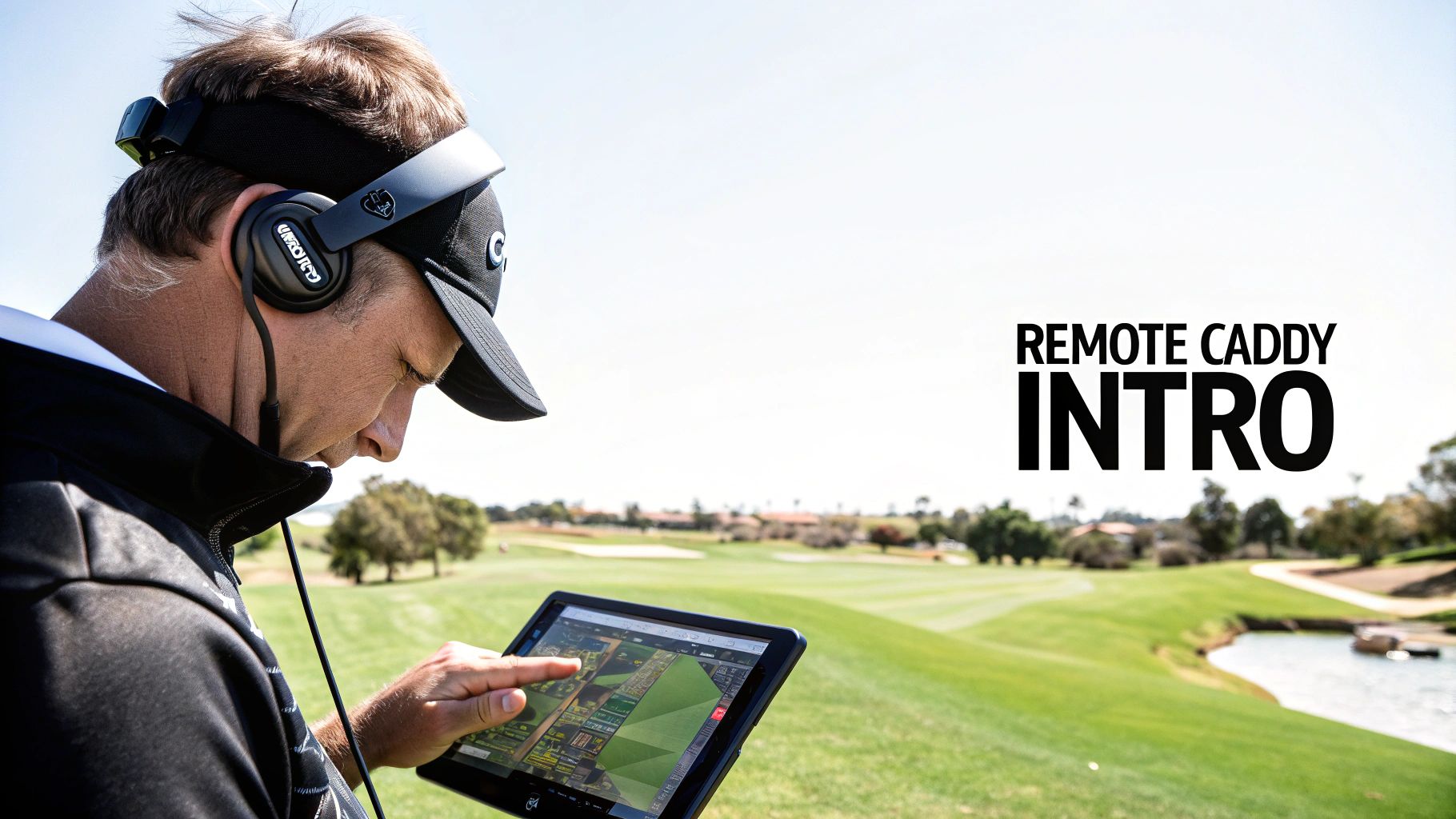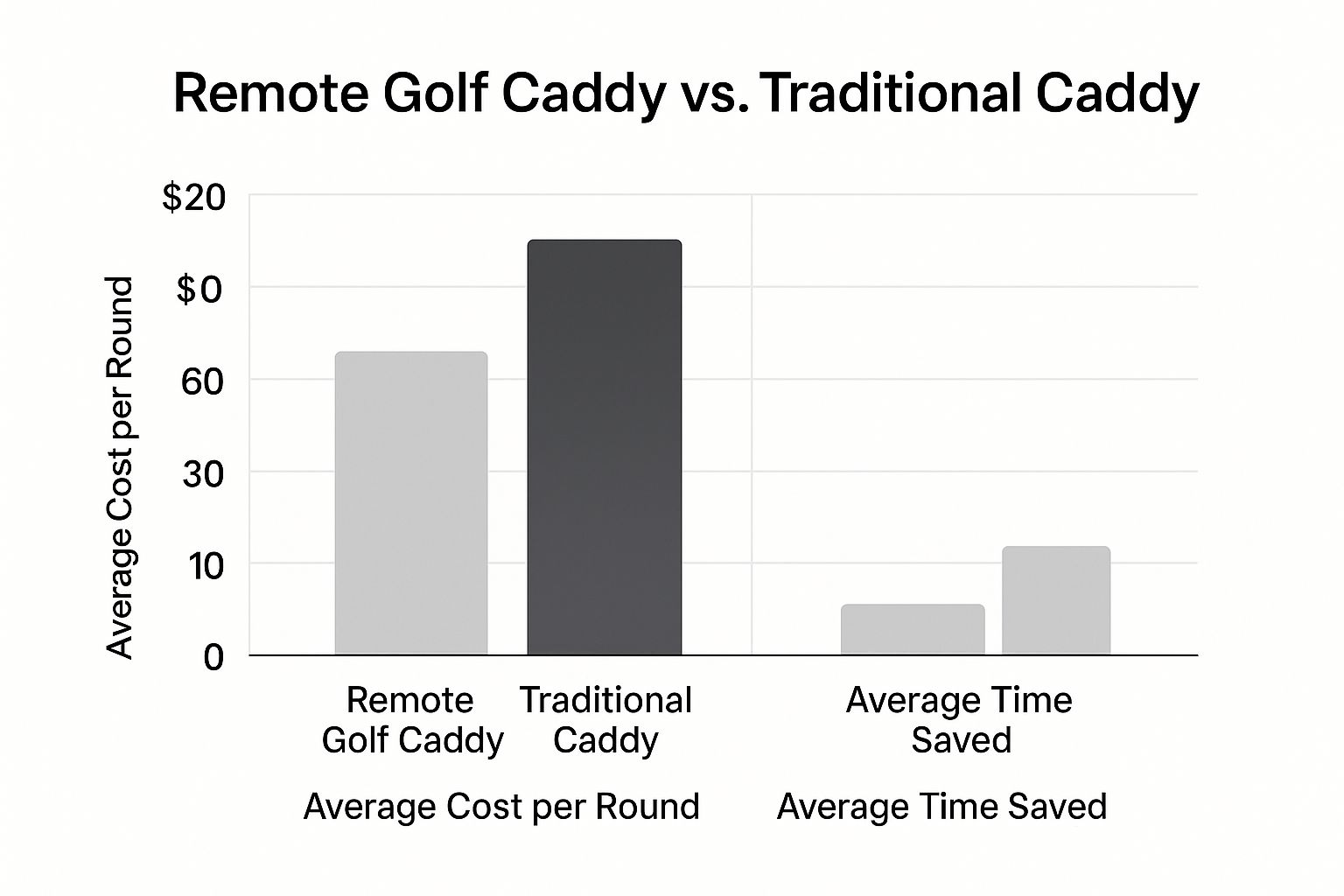Picture this: a loyal, robotic partner gliding silently ahead of you, carrying your clubs and letting you walk the course completely unburdened. You’re free to soak in the surroundings and focus entirely on your next shot. That's the simple, brilliant idea behind remote golf caddies.
These aren't your grandpa's old pull carts. They're motorized trolleys operated with a simple handheld remote, freeing you from the physical slog of pushing or pulling a heavy bag across 18 holes.
What Are Remote Golf Caddies

Think of a remote golf caddy as the perfect sweet spot between lugging your own bag and hiring a human caddy. It’s your personal equipment porter, giving you the freedom to stroll the fairways while keeping your clubs just a button-press away. This one change can completely transform the dynamic of your round.
Instead of huffing and puffing your way up a hill only to arrive at your ball winded, you get there fresh. That saved energy is a massive advantage, especially over those crucial last few holes where fatigue so often leads to sloppy mistakes. By offloading the grunt work, you can channel all your mental and physical energy toward what really counts: your swing, your strategy, and your love for the game.
The Rise of a Modern Golf Solution
The buzz around these devices isn't just a fleeting trend. It points to a real shift in how golfers are approaching the game, putting a premium on both performance and pure enjoyment. The market for remote-controlled electric golf caddies has been on a solid growth path, starting from a valuation of around USD 165 million in 2012.
Experts predict this market will climb to about USD 241 million by 2031, which shows just how much golfers are embracing this technology. The popularity is rooted in a simple truth: walking the course is one of golf's greatest pleasures, but wrestling with a 30-pound bag can quickly suck the fun out of it. A remote caddy solves this problem beautifully.
The key benefit is decoupling the act of walking from the act of carrying. You get all the health benefits of walking the course without the physical penalty of lugging your equipment. This makes the game more accessible and enjoyable for a wider range of players.
Manual Carts vs Remote Caddies
Let's be clear: a standard push cart is a definite upgrade from carrying your bag on your shoulders. But a remote caddy offers a completely different level of convenience and freedom. The main difference boils down to one thing: effort. With a manual cart, you are still the engine. You provide all the force needed to move it across every fairway, hill, and rough patch.
To give you a clearer picture, here's a quick breakdown of how they stack up.
At a Glance: Manual Push Cart vs Remote Golf Caddy
This table provides a quick comparison of the key differences between using a traditional manual push cart and a modern remote golf caddy.
| Feature | Manual Push Cart | Remote Golf Caddy |
|---|---|---|
| Effort Required | High - you provide all the pushing/pulling power. | Minimal - a battery-powered motor does all the work. |
| Operation | Hands-on; must physically steer and push. | Hands-free; operated with a small handheld remote. |
| Energy Impact | Can lead to fatigue, especially on hilly courses. | Conserves significant energy, keeping you fresh for all 18 holes. |
| Focus on Game | Divided between playing and managing the cart. | Allows full focus on shot-making and course strategy. |
| Cost | Lower initial investment. | Higher initial investment, but with greater convenience. |
| Convenience | Good - better than carrying. | Excellent - the ultimate in on-course freedom and ease. |
The table makes it obvious: while manual carts are a step in the right direction, remote caddies are in a league of their own.
With remote golf caddies, a quiet, battery-powered motor does all the heavy lifting. You simply guide it with a small remote, sending it ahead to your ball or having it cruise alongside you. This hands-free operation conserves a surprising amount of energy. To see how different models deliver on this promise, check out our guide to the best remote control golf trolley models for more detailed comparisons.
How a Remote Caddy Transforms Your Golf Game
Making the switch to a remote caddy is about so much more than just convenience. It fundamentally changes how you approach a round of golf. It’s not simply about not having to carry your bag; it’s about reclaiming the physical and mental energy that directly translates into better shots and a far more satisfying day on the course.
Think about your typical 18-hole round. You’re walking, on average, four to five miles, and that’s often over hilly, uneven ground. Pushing or carrying a 30-pound bag over that distance is a legitimate workout, and by the back nine, that physical toll almost always starts showing up in your game. A remote caddy completely erases this burden.
Conserve Physical Energy for a Stronger Finish
Picture your physical energy as a full tank of gas when you step onto the first tee. Every time you shove your cart up a steep hill or drag it through thick rough, you’re burning that fuel. By the time you reach those challenging 16th or 17th holes, you might be running on fumes. That’s when you see tired swings, poor decisions, and those costly bogeys that ruin a good round.
A remote golf caddy acts as your personal porter, doing all the heavy lifting for you. You arrive at each shot feeling just as fresh as you did on the first tee. This preserved energy is your secret weapon.
Instead of losing power and focus down the final stretch, you maintain your strength and stamina. This means more powerful drives and more controlled iron shots right when it matters most, helping you close out your round with confidence.
Countless golfers report feeling significantly less fatigued after their round, which means they can play more often without the usual wear and tear. This is especially true for players on hilly courses where the physical demands are at their peak.
Gain a Strategic Advantage on the Course
Beyond the physical side, a remote caddy gives you a clear strategic edge by improving your pace of play and mental workflow. While your buddies are still huffing and puffing their carts toward their own shots, you can send your caddy ahead to your ball.
This simple action buys you precious moments. You get to the ball, unburdened, and can immediately start analyzing your next shot. You can check the wind, confirm your yardage, and visualize your swing without feeling rushed. It creates a much smoother, more deliberate rhythm for your game.
Here’s how it boosts your strategy:
- Better Pace of Play: Sending your caddy ahead means you’re ready to hit when it’s your turn, which helps speed up the entire group.
- Enhanced Focus: You walk directly to your ball and can immediately begin your pre-shot routine without any distractions.
- Smarter Decisions: With more time to think, you’re far less likely to make a rash decision or grab the wrong club in a hurry.
The Caddie Wheel, for example, puts this control in your hands with a simple remote. It allows you to direct your cart with minimal effort, seamlessly turning your existing push cart into a strategic tool that keeps you one step ahead.
Sharpen Your Mental Game
Golf is just as much a mental challenge as it is a physical one. When you offload the menial task of managing your bag, it frees up a surprising amount of mental bandwidth. Instead of your thoughts being cluttered with how to get your cart around a bunker or up a steep slope, your mind is clear.
This newfound mental space lets you concentrate purely on course management and shot execution. You can focus on reading the green, strategizing your approach, and staying completely present in the moment. It’s the difference between being a player and being a pack mule.
Ultimately, remote golf caddies don't just carry your clubs—they carry the entire burden, letting you walk free and play your absolute best game.
The Technology Powering Your Caddy

At first glance, a remote golf caddy almost seems to work by magic. It glides effortlessly across the fairway, anticipating your next move. But behind that smooth performance is a smart combination of powerful, proven technologies working in perfect harmony.
You don’t need an engineering degree to get it. Just think of it like a well-drilled team where every player has a crucial role. From the battery that provides the stamina to the motors that supply the muscle, each component is fine-tuned for one thing: reliability on the course. Let’s pop the hood and see what makes these machines such incredible partners.
The Heartbeat of the Caddy: The Battery
The absolute powerhouse of any remote caddy is its battery. Most modern units, including the Caddie Wheel, run on high-capacity lithium-ion batteries. This is the same trusted technology that powers your smartphone and even electric cars, prized for its ability to cram a ton of energy into a surprisingly small and lightweight package.
A top-notch battery is the difference between a caddy that dies on the back nine and one that can easily tackle 36 holes on a single charge. It’s what supplies the steady power needed to climb steep hills and push through thick rough without ever missing a beat.
A strong, long-lasting battery isn't just a feature—it's non-negotiable. It’s the fuel in the tank, and you need to be confident it has enough juice to finish the round strong, no matter how long it takes.
The Brains of the Operation: The Remote System
If the battery is the heart, then the remote control system is definitely the brain. It's the critical link that gives you precise, real-time command over your caddy from a distance. A good remote translates every button press—forward, reverse, left, right, and stop—into an immediate action on the course, with zero frustrating lag.
Imagine driving a car where the steering has a one-second delay. It would be chaotic. The same logic applies here. An effective remote gives you that instant, intuitive control you need to navigate tight spots or stop on a dime, making remote golf caddies feel like a natural extension of your will.
The Muscle: Powerful and Quiet Motors
The battery brings the energy, but the motors do all the heavy lifting. These are the unsung heroes that convert all that electrical power into pure motion, propelling your fully-loaded golf bag across the course. Quality remote caddies use motors engineered for two things: power and silence.
They have to be brawny enough to handle steep inclines without a hint of strain, yet quiet enough that their sound never distracts you or your playing partners. The goal is a caddy that glides along so silently you almost forget it’s there. That blend of raw strength and stealth is the true sign of a well-designed machine.
Advanced Features for Stability and Safety
Beyond the core components, the best modern caddies are packed with advanced tech designed to keep them stable and safe, especially when the course gets tricky. These are the thoughtful details that take a caddy from good to great.
- Gyroscopic Stabilizers: Think of this as an inner-ear for your caddy. It helps the unit maintain its balance on sidehills and bumpy ground, dramatically cutting the risk of it tipping over and scattering your expensive clubs.
- Automatic Downhill Braking: This is a crucial safety feature. It automatically regulates the caddy's speed on steep descents, preventing it from getting away from you. It gives you complete control and peace of mind on hilly courses.
This kind of smart integration is becoming the new standard. The autonomous golf caddy market is at the forefront of golf’s technological shift, blending AI, GPS, and advanced sensors to completely redefine how we interact with our gear. To see how these robotic caddies are learning to navigate courses on their own, you can read the full report on the autonomous caddy market. These innovations are turning a simple gadget into a truly reliable on-course assistant.
How to Choose the Right Remote Golf Caddy
Picking out the right remote golf caddy isn't about finding the single "best" one on the market. It’s about finding the one that’s perfect for your game, your budget, and the course you call home. Think of it like buying a new driver—what’s a game-changer for your buddy might not be the right fit for you. A golfer who plays a flat, wide-open track has completely different needs than someone battling steep hills and tight fairways every weekend.
This guide will help you cut through the noise and zero in on what really matters. We’ll break down the essential features you should look for, helping you sort the absolute necessities from the nice-to-have bells and whistles. By the end, you’ll have a solid game plan for making a smart, confident choice.
This infographic breaks down just how much you can save in both time and money by using a remote caddy instead of hiring a traditional one.

The numbers speak for themselves. While there's an upfront cost, a remote caddy quickly pays for itself in long-term savings and a better pace of play.
Assess Your Course and Your Game
First things first: take an honest look at where and how you play golf. The terrain of your home course is easily the most important factor in deciding which features to prioritize.
-
For Hilly Courses: If your course has serious elevation changes, a model with a powerful motor and, most importantly, automatic downhill braking is an absolute must. This critical safety feature keeps the caddy from getting away from you on steep declines, ensuring you have total control. You should also look for caddies with a low center of gravity and gyroscopic stabilizers to keep them from tipping on sidehill lies.
-
For Flatter Courses: If you play on mostly level ground, you can put less focus on pure climbing power. Instead, you can prioritize other great features like battery life, portability, and how much the unit weighs.
Next, think about your own needs. Are you looking for the simplest, most straightforward remote possible, or are you drawn to more advanced tech? Do you drive a small car where a compact, easy-to-fold design is crucial? Answering these questions honestly will help you narrow down the field in a hurry.
Key Feature Comparison for Remote Golf Caddy Shoppers
A detailed look at essential features to compare when selecting a remote golf caddy, helping you match features to your personal needs and budget.
| Feature | What to Look For | Why It Matters |
|---|---|---|
| Battery Life | Lithium-ion with a rating for at least 27 holes, preferably 36. | Ensures you can finish your round (and maybe an extra nine) without worrying about running out of power. |
| Motor Power | Dual motors for better traction and climbing ability on varied terrain. | Provides the necessary strength to handle hills and thick rough without straining or slowing down. |
| Stability | A wide wheelbase and low center of gravity. Anti-tip features are a huge plus. | Prevents the caddy from tipping over on uneven ground, protecting your clubs and your investment. |
| Portability | A lightweight frame and a simple, one-step folding mechanism. | Makes it much easier to load into your car and store at home without a struggle. |
| Remote Control | An intuitive, responsive remote with a comfortable grip and clear buttons. | Guarantees you have precise, lag-free control to navigate the course safely and effectively. |
Once a caddy checks these fundamental boxes, you can start looking at the extras. Things like built-in GPS, USB charging ports for your phone, or full-blown "follow-me" automation are fantastic additions, but they will drive up the price. If you want to take a deeper dive into what makes a great caddy, you can discover the best remote golf caddy for your game in our comprehensive buyer's guide.
At the end of the day, picking the right remote golf caddy is a personal decision. By focusing on your course, your physical needs, and the core features that promise reliability, you’ll find a machine that doesn’t just carry your clubs—it genuinely improves every round you play.
The Rise of Autonomous Follow-Me Caddies

While standard remote-control caddies were a huge leap forward, the next frontier in golf automation is already here. Welcome to the world of autonomous “follow-me” caddies—a technology that takes the hands-free experience to a completely different level.
Just imagine strolling down the fairway, totally focused on your next shot, while your caddy trails behind you like a loyal companion. There’s no steering, no stopping, no starting. These advanced machines use a slick combination of AI, camera sensors, and GPS to lock onto your position and follow you around the course automatically. It’s the closest thing to having a human caddy, just without the small talk.
This evolution is part of a bigger trend toward smarter, more convenient golf gear. The global market for electric remote control golf carts, valued at around USD 1.2 billion in 2024, is projected to nearly double to almost USD 2.5 billion by 2033. This boom shows a clear demand for tech that makes the game more fun. You can discover more insights about this market expansion and see just how fast this part of the industry is growing.
How Does Follow Technology Actually Work?
The real magic behind these autonomous caddies is in their guidance systems. Unlike basic remote golf caddies that depend entirely on your commands, follow models use some pretty impressive tech to navigate on their own.
Most of them work by using a mix of visual and signal-based tracking. The golfer typically wears a small clip-on sensor or holds a remote that sends out a signal. The caddy's built-in sensors and cameras then lock onto that signal, allowing it to keep a steady distance from you as you walk. It’s almost like having an invisible string connecting you to your gear.
A key advancement in these models is their intelligent obstacle avoidance. Using a suite of sensors, the caddy can detect and steer around hazards like sand traps, trees, or even other golfers, ensuring a safe and seamless trip down the fairway.
Beyond Following: Groundbreaking Features
The best follow-me caddies are way more than just robotic pack mules. They’re becoming data-rich partners that can even give you insights into your game and physical performance on the course.
Here are a few of the standout features you’ll find on premium models:
- Multiple Operating Modes: Many offer different settings beyond just "Follow." A "Marching" mode might send it ahead to a specific spot, while a standard "Remote" mode gives you full manual control when you need it.
- Advanced Stability Systems: To handle all kinds of course conditions, these caddies often have robust anti-tipping systems. They can tackle slopes of up to 25 degrees without losing their balance.
- Performance Tracking: Some units can log key stats from your round, like the total distance you walked and your pace of play. This data helps you understand your physical output and manage your energy better.
The Ultimate Hands-Free Golfing Experience
The biggest benefit of a follow-me caddy is achieving a state of complete freedom on the course. You can stick the remote in your pocket and forget about it, letting you walk with a natural rhythm, chat with your buddies, and put 100% of your mental energy into your game.
This technology represents the peak of on-course convenience, blending robotics and AI to create an experience that feels truly effortless. While standard remote golf caddies—like those powered by the Caddie Wheel—remove the physical chore of pushing, these autonomous models take away that final bit of mental effort needed to operate them. They offer a compelling peek into a future where automation handles all the logistics, leaving you with nothing but the pure enjoyment of golf.
Protecting Your Investment with Proper Maintenance
A remote caddy is a serious investment in your golf game, and just like any other piece of high-performance equipment, it needs a little TLC to keep running smoothly. Think of it like a car—a few simple, routine checks go a long way in guaranteeing it’s reliable and ready to go for years to come. By putting in a few minutes of care after each round, you protect your gear and ensure it’s always ready to perform.
The single most important component to look after is the battery. Today’s lithium-ion batteries are tough, but their lifespan is directly linked to how you charge and store them. Get those habits right, and you’ll dramatically extend its life, ensuring you always have enough juice to finish 18 holes, and then some.
Smart Battery Care for Maximum Longevity
Your caddy’s battery is its heart, so keeping it healthy should be priority number one. Bad charging habits are the fastest way to kill its capacity and shorten its life.
- Avoid Deep Discharges: Make it a habit to recharge the battery after every round, even if it was just 18 holes. Constantly running it down to empty puts unnecessary stress on the battery cells.
- Use the Right Charger: Always, always use the charger that came with your caddy. It’s specifically designed to deliver the correct voltage and amperage, which prevents overcharging and potential damage.
- Store It Properly: If you’re putting the caddy away for the off-season, store the battery in a cool, dry place (inside is best) at roughly 50-70% charge. Leaving it fully charged or completely dead for months is a recipe for degradation.
Follow these simple steps, and your battery will deliver consistent power, round after round.
Protecting your battery isn't just about performance; it’s about value. A well-maintained battery can last for hundreds of charge cycles, saving you the significant cost of a premature replacement.
Your Regular Maintenance Checklist
Beyond the battery, a quick post-round inspection can catch small issues before they become big problems, keeping your remote golf caddy in peak condition. Over time, things like grass, mud, and sand can build up and start to affect how it rolls and folds.
A simple cleaning and inspection routine is all it takes. While a full-sized golf cart has more extensive needs, the core principles of preventative care are the same. You can learn more in our guide on how to save money and extend your cart’s life with smart maintenance.
Here’s a quick checklist to run through:
- Clean the Frame and Wheels: Grab a damp cloth and wipe down the frame. Use a brush to get any caked-on mud, grass, or sand out of the wheels and axles so they can spin freely.
- Check All Connections: Give the key connection points a quick look. Make sure all bolts, screws, and brackets are tight, paying special attention to the wheel attachments and folding mechanisms.
- Inspect Moving Parts: Check that all the moving parts, especially the joints and hinges for folding, are clear of debris and operate smoothly.
- Test Remote Functionality: Before heading out for your next round, do a quick remote test. Make sure it pairs correctly and that all the commands are responsive.
This straightforward routine takes maybe five minutes, but it's the best insurance you can get for your investment. It ensures your caddy remains a dependable partner on the course.
Frequently Asked Questions
Even after you're sold on the idea of a remote caddy, it’s completely normal to have a few practical questions about how they actually perform out on the course. Let's tackle some of the most common ones golfers ask before they make the switch.
How Much Do Remote Golf Caddies Cost?
This is usually the first question on everyone's mind, and the truth is, the price can vary quite a bit. You’ll find simple, reliable models starting around $800 to $1,200. For the high-end units packed with advanced features like autonomous "follow" modes or built-in GPS, the price can easily climb past $2,500. It's all about weighing that upfront cost against the long-term savings on human caddy fees and, just as importantly, the boost in pure enjoyment.
Of course, there's a smarter, more budget-friendly way to get in on the action. Conversion kits like the Caddie Wheel offer a fantastic alternative. These kits let you motorize the push cart you already own and trust, giving you all the core remote-control functionality without the hefty price tag of a brand-new unit.
How Do They Handle Hills and Rough Terrain?
This is a make-or-break question, and the answer really comes down to the quality of the caddy. Top-tier models are engineered from the ground up to conquer challenging courses.
- Powerful Motors: They typically feature dual motors that provide all the torque needed to power up steep inclines without skipping a beat.
- Built-in Stability: A wide wheelbase and a low center of gravity are crucial for preventing tips and spills when you're on an awkward sidehill lie.
- Downhill Braking: This might be the single most important feature for hilly tracks. Automatic downhill braking stops the caddy from getting away from you on descents, keeping you in complete, safe control.
Be warned, cheaper models often struggle on anything more than a flat fairway. It’s a good idea to think about the typical terrain of your home course before you decide.
A lot of golfers are genuinely surprised by how gracefully a quality remote caddy navigates hills. The secret is a design that puts stability first, often including an anti-tip wheel to make sure your clubs are safe no matter where your ball lands.
Is the Technology Complicated to Use?
Not in the slightest. While the internal tech is sophisticated, the best remote golf caddies are designed to be incredibly simple and intuitive. The handheld remote usually has just a few obvious buttons: forward, back, left, right, and stop. Pairing it with the caddy is a one-time thing that takes just a few seconds.
The whole point is to make the technology fade into the background so you can focus on your next shot. Most new owners feel completely comfortable with the controls within the first few holes. Before you know it, guiding your cart becomes pure muscle memory.
Ready to transform your walk and lock in on your game? The Caddie Wheel turns your trusted push cart into a powerful remote caddy, delivering the freedom you want at a price that makes sense. Learn more and get yours today at CaddieWheel.com.


Share:
Your Guide to Hand Golf Carts and Upgrades
Your Guide to Push Pull Golf Carts